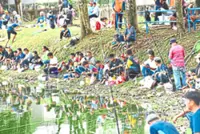Tasik Aman in Taman Aman park in Section 22, Petaling Jaya is a disused tin-mining pool. — FAIHAN GHANI/The Star
ONCE a place of leisure with a vibrant ecosystem, Petaling Jaya’s Tasik Aman is now a murky green expanse due to microalgae that has inundated the 2ha-wide lake.
Scientists from two separate universities are collaborating to gather data on the lake’s dynamics to find the reason for Tasik Aman’s decline.





